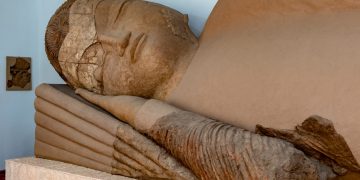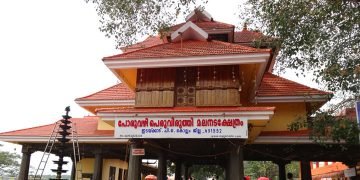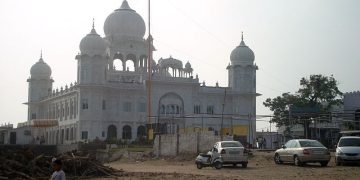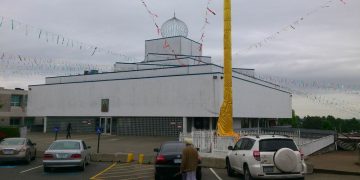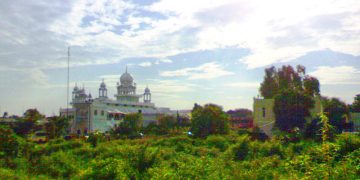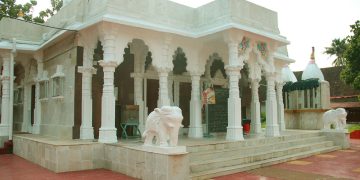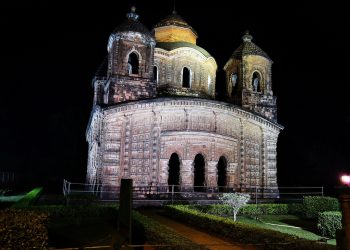Neela Megha Perumal Temple or Sowriraja Perumal Temple in Thirukannapuram is dedicated to the Hindu god Vishnu.It is one of the 108 Divyadesam dedicated to Vishnu, who is worshipped as Neelamegha Perumal and his consort Lakshmi as Tirukannapura Nayagi.
Shrine’s History
Constructed in the Dravidian style of architecture, the temple is glorified in the Divya Prabandha, the early medieval Tamil canon of the Azhwar saints from the 6th?9th centuries AD
Legends Associated with This Shrine
As per Hindu legend, Rangabhatta an ardent devotee and priest of the temple offered a garland to the presiding deity daily offered by a courtesan. The courtesan used to wear the garland before offering to the priest. One day, the ruling king found a hair in the garland asked the priest about it. The priest said that the hair was that of the deity himself. The king thought that priest was lying and wanted to punish him. While he checked the deity, Vishnu himself appeared with a Sowri . Since Vishnu appeared with Sowri, he is called Sowrirajan in the temple.
Architectural Relevance of This Shrine
The temple has a 7-tier rajagopuram about 100 ft and a vast temple complex measuring 1.5 acres . The complex measures 316 ft from East to West and 210 ft from North to South. The second gateway tower approached from the main gateway, measures 60 ft. The image of the presiding deity, Neela Meghar, is housed in the sanctum, which is approached through the gateways and the Mahamandapa. The sanctum also houses the image of Sridevi and Bhoodevi on either side of Neelameghar, Dandaka Maharishi and Garuda.
The metal image of the festival deity, Sowriraja Perumal, is also housed in the sanctum, with four consorts namely Sridevi, Bhudevi, Padmini and Andal. There are also metal images of Santhana Krishnar and Chakrathaazhwar. The temple tank is situated right opposite to the temple. The hall preceding the sanctum is called Mahamandapa and the northern part of it is called Tirumanjana Mandapam, where the sacred bath is performed to the festive images during festivals. The Palliarai is the sacred chamber where the festive images of Vishnu and his consort are housed during festivals.
There are separate shrines for Senai Mudaliar , Nardhana Krishna, the twelve Azhwars, Rama, Consort of presiding deity and Thaylapura Nayagi. There are four temple tanks associated with the temple, with the largest, Nityapushkarani, located opposite the temple measuring 450 ft by 415 ft . Ksheerapati Pushkarani, Bhootavadan and Muthakaram are other three tanks of the temple. As per a legend, the original structure extended up to seven compounds and 13 miles leading to the seashore. The ruling Chola ruler was against Vaishnavism and wanted to destroy the temple. An ardent devotee pleaded to Vishnu to appear and destruct the ruler. Vishnu was unmoved and in anger, the devotee through a discuss at the image, creating a scar. It is believed that the scar is seen in the image even during modern times.
The presiding deity threw a discus to hurl the Chola forces. The image of the presiding deity is depicted hurling a discus. In modern times, the temple is maintained and administered by the Hindu Religious and Endowment Board of the Government of Tamil Nadu
Shrine’s Map Location and How to Go There
By Road
Nagapattinam is connected by two national highways, NH 45A to Villupuram and NH 67 to Coimbatore and Gundlupete in Karnataka state. Nagapattinam is also connected with Chennai, Coimbatore, Tiruchirapalli, Karaikal and other major towns of Tamil Nadu.
By Rail
Nagapattinam railway junction connects Thiruvarur in the west, Nagore in the north, Velankanni in the south and Karaikal in the east. There is a daily express train to Chennai via Mayiladuthurai and Ernakulam via Coimbatore and it connects all major cities.
By Air
The nearest Airport to reach the temple is Tiruchirapalli Airport, located 145 km away from the town.
Shrine Timings
6A.m to 12:30 P.M and 4:30 P.M to 8 P.M
Events Celebrated at This Shrine
Masi Magam Festival February to March
Vaikasi Brahmotsavam Festival December to January
Chitra Poornima Festival April to May
Aadi Pooram Festival July to August
Navaratri Festival September to October
Karthikai Festival November to December
Pangunu Uthiram Festival March to April
Makar Sankranti January
Extra Information About this Shrine
Nearby Temple
Kayaroganeswarar Temple
Thanthondreeswarar Temple
Loganatha Perumal Temple
Pallavaneswarar Temple
Aranyeswarar Temple
Naganathar Temple



